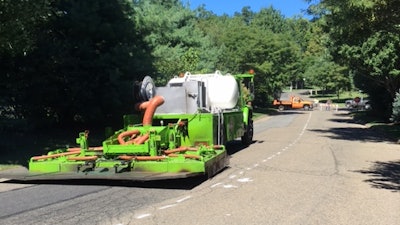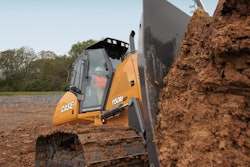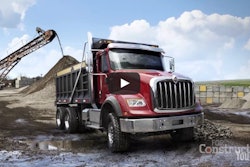
With a population of almost 60,000, Fairfield is located along the Gold Coast of Connecticut’s panhandle and rests in one of the wealthiest regions of the state.
Garrity Pavement Services was tasked last fall with a 20,000-square-yard heater scarification project for the town.
While the Garrity family has been serving the asphalt industry since 1966, last season with the first for Garrity’s new hot in-place division. Headquartered in Bloomfield, CT, Garrity Pavement Services currently has one crew and recycling train but anticipates adding a second crew and train mid-season 2017.
Challenges before beginning
With the hot in-place division being a start-up and the project so late in the season, it had to overcome some major obstacles, says John Danello, vice president of operations and business development for Garrity. The first challenge was properly working equipment.
“There are no large suppliers of heater scarification machinery in the U.S.,” explains Danello. “Most of our machinery is custom produced by us or very small manufacturers. With the smaller suppliers, you’re on their timetable and held to their time constraints.
“Then, right out of the gate, there were some catastrophic hydraulic failures on the equipment which we had to repair before beginning the project,” he says.
Because of the late start, the second challenge Garrity had was to find and train another crew in order to get the job done in a timely fashion. The startup looked to Asphalt Repair Solutions Inc. out of Newtown, CT, for a helping hand.
“We have a business relationship that allows our two companies to share resources on an as-needed basis,” says Danello. “They were chosen for their attention to detail and paving expertise.”
In addition to equipment being delivered late and some of it needing major repairs, the final challenge Garrity Pavement Services faced as a startup was finding a public works director willing to step outside the box. This was only the second time Fairfield had used the HIPR process.
Scott Bartlett, superintendent with the Department of Public Works in Fairfield, had seen the process done, but wasn’t completely sold.
“Fairfield tried HIPR about 20 years ago,” says Bartlett. “We liked the concept, but didn’t have the best results. We felt the new technology deserved another try.”
Danello adds, “When Scott and I spoke about the quality control aspect that Garrity Pavement Services brought to the table, as well as educating him on all of the benefits of HIPR, he was willing to put a bid out and we were awarded our first job in Connecticut.
“Scott recognized the value of reusing his existing materials and understood that even though we are just reworking the top inch to inch and a half, the thermal values go deeper into the road mending the existing cracks back together inches below the top recycled surface.”
Fairfield streets
The two streets that Garrity was tasked with recycling for Fairfield had substantial cracking, delaminations, pot holes, and an uneven driving surface. And they were also present in a high-profile neighborhood.
“These neighborhoods had a lot of ornamentals and trees that could not be damaged,” Danello says. “The streets were also short but very wide, and required three passes.”
The asphalt being recycled on these streets also contained chip seal and special care had to be given to not overheat the surface of the roadway.
“The chip seal will get recycled back into the existing materials during the HIPR process,” says Danello. “It’s very hard to recycle chip seals. If they’re not heated correctly, they will tend to ignite and cause damage to the machinery.
“You must adjust your oven temperature and travel speed to find the correct combination of the two to successfully recycle chip seals,” he says. “Most hot in-place contractors walk away from recycling chip seals.”
HIPR train
The HIPR train in this recycling project included one pre-heater, one recycler, and a roller. There was also an onsite service truck for oil and water supply. Additionally, Garrity always has a heavily outfitted mechanic’s truck just in case there is an equipment failure.
The short, wide nature of the streets posed a challenge for the HIPR train, and a high level of coordination was needed to keep the operation moving.
“When the pre-heater operator got to the end of the first pass, he would wait for the recycler to get to the end, and as the recycler was getting into position, the pre-heater went into operation just ahead of the recycler,” Danello says.
“This allowed us to keep traffic flowing without hindering the daily production goals,” he continues. “Because the wide streets required three passes, we had to straddle the crown of the road while maintaining the original profile of the road.”
Danello says the company’s customized screed design allowed them to “add crown” to the screed and pull a center pass while maintaining the existing road profile and alignment.
Successful completion
Overall the project was a success despite its initial challenges. The HIPR process reduced truck traffic, offered a lower carbon foot print than other options, and eliminated existing cracks in the road. There was no damage done to the ornamentals or trees. Patches and repairs blended into the existing surface making the completed surface monolithic.
The Town of Fairfield realized a substantial cost savings and is planning to do more HIPR to its roads in 2017.
“The biggest benefit Fairfield saw was the recycling and reusing the material in place,” says Bartlett. “We also improved the ride by adding thickness back to the road and sealing cracks beneath the treated surface.”
Despite the challenging road selection, Bartlett says he was satisfied with the project. In hindsight, he says, he would probably not use it on a heavy chip-sealed road again however.
“With the chip seal, the emulsion seemed to reflect the heat and wouldn’t allow uniformed penetration,” he says. “I would use this process on an asphalt road and even try it on a microsealed road to see results.”
Bartlett says he is a strong believer in pavement preservation, and that the HIPR process definitely has a place in Fairfield's tool box for future use.
“I feel in order to maintain any agency infrastructure, you must keep a variety of tools available to keep your network in good shape,” he says. “This is another tool if the proper road is selected.”
Despite the initial bumps, Danello is also pleased with how the project turned out and feels Garrity Pavement Services will enhance the preservation experience on the East Coast.
“There are now two contractors performing HIPR in New England, which gives the municipalities of New England two options on their projects,” says Danello. “I’m very proud of how the Garrity Companies came together as a whole to overcome all these challenges and produce a quality project.”

![Fcp Racatac Chair 10893876[1]](https://img.forconstructionpros.com/mindful/acbm/workspaces/default/uploads/2025/10/fcp-racatac-chair-108938761.10l0At5WXv.png?auto=format%2Ccompress&bg=fff&fill-color=fff&fit=fill&h=100&q=70&w=100)







![Fcp Racatac Chair 10893876[1]](https://img.forconstructionpros.com/mindful/acbm/workspaces/default/uploads/2025/10/fcp-racatac-chair-108938761.10l0At5WXv.png?ar=16%3A9&auto=format%2Ccompress&bg=fff&fill-color=fff&fit=fill&h=135&q=70&w=240)



![Building Angled Sm Edit 6050b8d213f1b[1]](https://img.forconstructionpros.com/mindful/acbm/workspaces/default/uploads/2025/09/building-angled-sm-edit6050b8d213f1b1.Ygq5aAos3b.png?ar=16%3A9&auto=format%2Ccompress&crop=focalpoint&fit=crop&fp-x=0.53&fp-y=0.23&fp-z=2&h=135&q=70&w=240)




